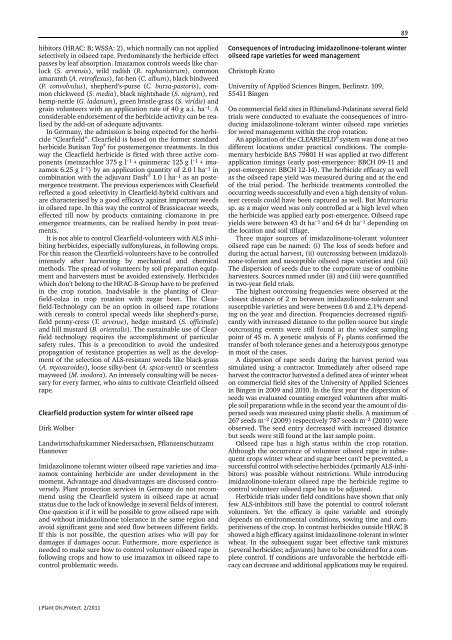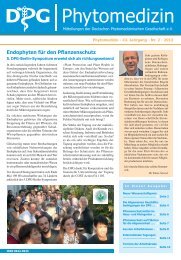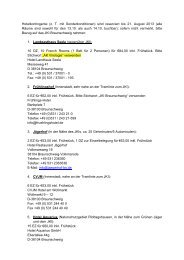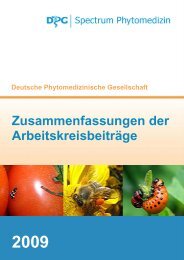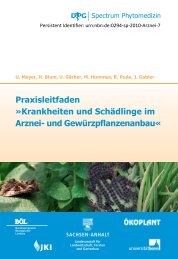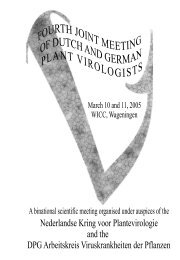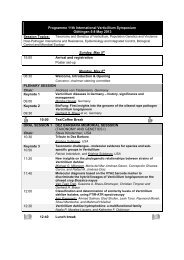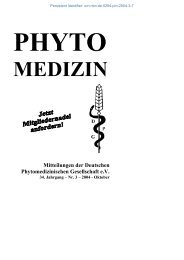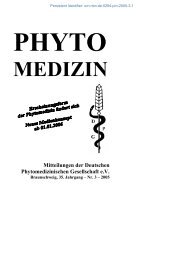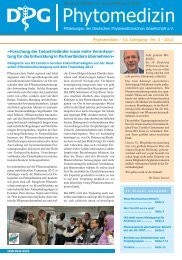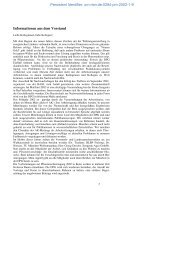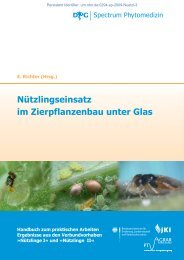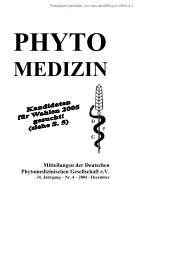Zusammenfassungen der Arbeitskreisbeiträge - Die DPG
Zusammenfassungen der Arbeitskreisbeiträge - Die DPG
Zusammenfassungen der Arbeitskreisbeiträge - Die DPG
Erfolgreiche ePaper selbst erstellen
Machen Sie aus Ihren PDF Publikationen ein blätterbares Flipbook mit unserer einzigartigen Google optimierten e-Paper Software.
hibitors (HRAC: B; WSSA: 2), which normally can not applied<br />
selectively in oilseed rape. Predominantly the herbicide effect<br />
passes by leaf absorption. Imazamox controls weeds like charlock<br />
(S. arvensis), wild radish (R. raphanistrum), common<br />
amaranth (A. retroflexus), fat-hen (C. album), black bindweed<br />
(P. convolvulus), shepherd‘s-purse (C. bursa-pastoris), common<br />
chickweed (S. media), black nightshade (S. nigrum), red<br />
hemp-nettle (G. ladanum), green bristle-grass (S. viridis) and<br />
grain volunteers with an application rate of 40 g a.i. ha –1. A<br />
consi<strong>der</strong>able endorsement of the herbicide activity can be realised<br />
by the add-on of adequate adjuvants.<br />
In Germany, the admission is being expected for the herbicide<br />
“Clearfield”. Clearfield is based on the former standard<br />
herbicide Butisan Top ® for postemergence treatments. In this<br />
way the Clearfield herbicide is fitted with three active components<br />
(metazachlor 375 g l –1 +quinmerac 125g l –1 + imazamox<br />
6.25 g l –1 ) by an application quantity of 2.0 l ha –1 in<br />
combination with the adjuvant Dash ® 1.0 l ha –1 as an postemergence<br />
treatment. The previous experiences with Clearfield<br />
reflected a good selectivity in Clearfield-hybrid cultivars and<br />
are characterised by a good efficacy against important weeds<br />
in oilseed rape. In this way the control of Brassicaceae weeds,<br />
effected till now by products containing clomazone in pre<br />
emergence treatments, can be realised hereby in post treatments.<br />
It is not able to control Clearfield-volunteers with ALS inhibiting<br />
herbicides, especially sulfonylureas, in following crops.<br />
For this reason the Clearfield-volunteers have to be controlled<br />
intensely after harvesting by mechanical and chemical<br />
methods. The spread of volunteers by soil preparation equipment<br />
and harvesters must be avoided extensively. Herbicides<br />
which don’t belong to the HRAC-B-Group have to be preferred<br />
in the crop rotation. Inadvisable is the planting of Clearfield-colza<br />
in crop rotation with sugar beet. The Clearfield-Technology<br />
can be an option in oilseed rape rotations<br />
with cereals to control special weeds like shepherd‘s-purse,<br />
field penny-cress (T. arvense), hedge mustard (S. officinale)<br />
and hill mustard (B. orientalis). The sustainable use of Clearfield<br />
technology requires the accomplishment of particular<br />
safety rules. This is a precondition to avoid the undesired<br />
propagation of resistance properties as well as the development<br />
of the selection of ALS-resistant weeds like black-grass<br />
(A. myosuroides), loose silky-bent (A. spica-venti) or scentless<br />
mayweed (M. inodora). An intensely consulting will be necessary<br />
for every farmer, who aims to cultivate Clearfield oilseed<br />
rape.<br />
Clearfield production system for winter oilseed rape<br />
Dirk Wolber<br />
Landwirtschaftskammer Nie<strong>der</strong>sachsen, Pflanzenschutzamt<br />
Hannover<br />
Imidazolinone tolerant winter oilseed rape varieties and imazamox<br />
containing herbicide are un<strong>der</strong> development in the<br />
moment. Advantage and disadvantages are discussed controversely.<br />
Plant protection services in Germany do not recommend<br />
using the Clearfield system in oilseed rape at actual<br />
status due to the lack of knowledge in several fields of interest.<br />
One question is if it will be possible to grow oilseed rape with<br />
and without imidazolinone tolerance in the same region and<br />
avoid significant gene and seed flow between different fields.<br />
If this is not possible, the question arises who will pay for<br />
damages if damages occur. Futhermore, more experience is<br />
needed to make sure how to control volunteer oilseed rape in<br />
following crops and how to use imazamox in oilseed rape to<br />
control problematic weeds.<br />
J.Plant Dis.Protect. 2/2011<br />
�<br />
: 89<br />
Consequences of introducing imidazolinone-tolerant winter<br />
oilseed rape varieties for weed management<br />
Christoph Krato<br />
University of Applied Sciences Bingen, Berlinstr. 109,<br />
55411 Bingen<br />
On commercial field sites in Rhineland-Palatinate several field<br />
trials were conducted to evaluate the consequences of introducing<br />
imidazolinone-tolerant winter oilseed rape varieties<br />
for weed management within the crop rotation.<br />
An application of the CLEARFIELD ® system was done at two<br />
different locations un<strong>der</strong> practical conditions. The complementary<br />
herbicide BAS 79801 H was applied at two different<br />
application timings (early post-emergence: BBCH 09-11 and<br />
post-emergence: BBCH 12-14). The herbicide efficacy as well<br />
as the oilseed rape yield was measured during and at the end<br />
of the trial period. The herbicide treatments controlled the<br />
occurring weeds successfully and even a high density of volunteer<br />
cereals could have been captured as well. But Matricaria<br />
sp. as a major weed was only controlled at a high level when<br />
the herbicide was applied early post-emergence. Oilseed rape<br />
yields were between 43 dt ha –1 and 64 dt ha –1 depending on<br />
the location and soil tillage.<br />
Three major sources of imidazolinone-tolerant volunteer<br />
oilseed rape can be named: (i) The loss of seeds before and<br />
during the actual harvest, (ii) outcrossing between imidazolinone-tolerant<br />
and susceptible oilseed rape varieties and (iii)<br />
The dispersion of seeds due to the corporate use of combine<br />
harvesters. Sources named un<strong>der</strong> (ii) and (iii) were quantified<br />
in two-year field trials.<br />
The highest outcrossing frequencies were observed at the<br />
closest distance of 2 m between imidazolinone-tolerant and<br />
susceptible varieties and were between 0.6 and 2.1% depending<br />
on the year and direction. Frequencies decreased significantly<br />
with increased distance to the pollen source but single<br />
outcrossing events were still found at the widest sampling<br />
point of 45 m. A genetic analysis of F1 plants confirmed the<br />
transfer of both tolerance genes and a heterozygous genotype<br />
in most of the cases.<br />
A dispersion of rape seeds during the harvest period was<br />
simulated using a contractor. Immediately after oilseed rape<br />
harvest the contractor harvested a defined area of winter wheat<br />
on commercial field sites of the University of Applied Sciences<br />
in Bingen in 2009 and 2010. In the first year the dispersion of<br />
seeds was evaluated counting emerged volunteers after multiple<br />
soil preparations while in the second year the amount of dispersed<br />
seeds was measured using plastic shells. A maximum of<br />
267 seeds m –2 (2009) respectively 787 seeds m –2 (2010) were<br />
observed. The seed entry decreased with increased distance<br />
but seeds were still found at the last sample point.<br />
Oilseed rape has a high status within the crop rotation.<br />
Although the occurrence of volunteer oilseed rape in subsequent<br />
crops winter wheat and sugar beet can’t be prevented, a<br />
successful control with selective herbicides (primarily ALS-inhibitors)<br />
was possible without restrictions. While introducing<br />
imidazolinone-tolerant oilseed rape the herbicide regime to<br />
control volunteer oilseed rape has to be adjusted.<br />
Herbicide trials un<strong>der</strong> field conditions have shown that only<br />
few ALS-inhibitors still have the potential to control tolerant<br />
volunteers. Yet the efficacy is quite variable and strongly<br />
depends on environmental conditions, sowing time and competitiveness<br />
of the crop. In contrast herbicides outside HRAC B<br />
showed a high efficacy against imidazolinone-tolerant in winter<br />
wheat. In the subsequent sugar beet effective tank mixtures<br />
(several herbicides; adjuvants) have to be consi<strong>der</strong>ed for a complete<br />
control. If conditions are unfavorable the herbicide efficacy<br />
can decrease and additional applications may be required.


